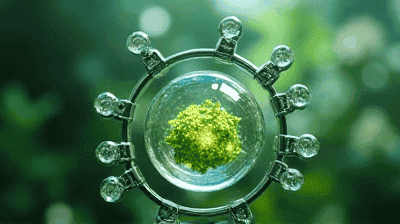
The quest for sustainable and clean energy sources has taken on unprecedented urgency in the context of global climate change and the depletion of fossil fuels. One promising avenue of exploration involves the concept of artificial photosynthesis, a process that aims to mimic the natural phenomenon by which plants convert sunlight, carbon dioxide, and water into energy-rich fuels.
Photosynthesis is the natural process by which green plants, algae, and some bacteria convert light energy from the sun into chemical energy stored in glucose. This process occurs primarily in the chloroplasts of plant cells and involves two main stages: the light-dependent reactions and the light-independent reactions (Calvin cycle).
Light-Dependent Reactions: These reactions occur in the thylakoid membranes of chloroplasts and involve the absorption of sunlight by chlorophyll and other pigments. Light energy is used to split water molecules into oxygen, protons, and electrons. This process generates ATP (adenosine triphosphate) and NADPH (nicotinamide adenine dinucleotide phosphate), which are energy carriers.
Calvin Cycle (Light-Independent Reactions): In this stage, ATP and NADPH produced in the light-dependent reactions are used to convert carbon dioxide from the atmosphere into glucose through a series of biochemical reactions. This stored energy can then be used by the plant for growth, reproduction, and metabolism.
Photosynthesis is vital for life on Earth for several reasons:
Oxygen Production: The process generates oxygen as a byproduct, which is essential for the survival of aerobic organisms, including humans.
Foundation of Food Chains: Photosynthesis forms the base of the food chain, providing energy for plants, herbivores, and ultimately carnivores.
Carbon Sequestration: By absorbing carbon dioxide from the atmosphere, photosynthesis helps mitigate the greenhouse effect and climate change.

Artificial photosynthesis refers to the development of synthetic processes that replicate the natural photosynthetic mechanism. The primary goal is to produce clean fuels—such as hydrogen, methanol, or other hydrocarbons—using sunlight, carbon dioxide, and water, effectively mimicking the natural ability of plants to convert solar energy into chemical energy.
Renewable Energy Source: By harnessing solar energy to produce fuels, artificial photosynthesis provides a renewable source that can reduce reliance on fossil fuels.
Carbon Dioxide Utilization: This technology has the potential to capture and convert CO2, addressing the challenge of excess greenhouse gases in the atmosphere while simultaneously producing energy.
Sustainable Production: Unlike conventional fuel production methods that rely on land and resources, artificial photosynthesis systems can be designed to use non-arable land, minimizing the impact on food production.
To create a successful artificial photosynthesis system, several key components are necessary:
Light Absorbers: These materials capture sunlight and convert it into usable energy. Commonly researched materials include semiconductors, dye-sensitized materials, and metals like titanium dioxide.
Catalysts: Catalysts facilitate chemical reactions without being consumed in the process. In artificial photosynthesis, catalysts are essential for converting CO2 and water into hydrocarbons or other fuels. These can be made from metals, metal oxides, or organic compounds.
Electron Transporters: These components are responsible for transferring electrons generated by light absorbers to the catalysts. The efficient transfer of electrons is crucial for driving the chemical reactions necessary for fuel production.
Reaction Chamber: This is where the various components interact, enabling the conversion of sunlight, water, and CO2 into fuel. The design of the reaction chamber can significantly influence the efficiency of the overall process.
The artificial photosynthesis process typically involves the following steps:
Light Absorption: Sunlight is captured by light-absorbing materials, which then generate excited electrons.
Water Splitting: The excited electrons are used to split water molecules into oxygen, protons, and electrons. This step releases oxygen as a byproduct.
CO2 Reduction: The electrons and protons are combined with carbon dioxide in a catalytic process to produce hydrocarbons or other fuels.
Fuel Extraction: The produced fuel can then be collected and utilized as a clean energy source.

Numerous research institutions and organizations are working on advancing artificial photosynthesis technologies. Some notable examples include:
The California Institute of Technology (Caltech): Researchers at Caltech have developed a solar-driven artificial photosynthesis system that uses sunlight to convert carbon dioxide and water into forms of renewable fuels like methanol and ethanol.
The Massachusetts Institute of Technology (MIT): MIT scientists are exploring various material combinations and designs for catalysts that can enhance the efficiency of CO2 reduction. Their work focuses on optimizing light-absorbing semiconductors for improved energy conversion.
European Union Initiatives: Various European research projects, such as the H2020 program, are dedicated to the development of artificial photosynthesis technologies. These programs aim to foster collaboration across countries and industries to accelerate advancements in this field.
Private Sector Innovators: Startups and private companies are also entering the arena, developing proprietary technologies for artificial photosynthesis aimed at commercial viability. Some are focusing on integrating these technologies with existing energy and carbon capture infrastructures.
The success of artificial photosynthesis heavily relies on advances in materials science. Researchers are exploring new materials that can serve as efficient light absorbers and catalysts. Some developments include:
Nanostructured Photocatalysts: Researchers are developing nanostructured materials that maximize surface area and improve light absorption. These materials have shown promise in enhancing the efficiency of sunlight conversion.
Metal-Organic Frameworks (MOFs): MOFs are highly porous materials that can selectively capture CO2 and have been studied for their potential in catalyzing the conversion of CO2 into fuels.
Biohybrid Systems: Some researchers are investigating the use of natural enzymes and proteins in combination with synthetic materials to create biohybrid systems that mimic the efficiency of natural photosynthesis.
Artificial photosynthesis presents a viable method for producing renewable energy from sunlight. Unlike fossil fuels, which release carbon emissions when burned, the fuels generated through artificial photosynthesis have the potential to be carbon-neutral.
By utilizing CO2 from the atmosphere as a raw material, artificial photosynthesis offers an opportunity to reduce greenhouse gas concentrations in the atmosphere. This process aligns with global efforts to combat climate change and achieve carbon neutrality.
The fuels produced through artificial photosynthesis can be stored and used on-demand, providing an efficient means of energy storage. This capability is essential for balancing energy supply and demand in renewable energy systems.
Artificial photosynthesis systems can be deployed in a variety of locations, including regions unsuitable for traditional agriculture. This flexibility allows for energy production without competing for arable land and reduces the environmental impact associated with food production.
The development of artificial photosynthesis technologies could lead to the creation of new industries and job opportunities in sectors related to renewable energy, chemical engineering, and environmental research.

While the potential of artificial photosynthesis is significant, several challenges must be addressed to facilitate its widespread adoption:
Current artificial photosynthesis systems often struggle to achieve efficiencies comparable to natural photosynthesis. Researchers must continue to optimize light absorption, reaction rates, and catalytic processes to enhance overall efficiency.
Scaling up artificial photosynthesis technologies for commercial production requires significant investment and development of infrastructure. Addressing the logistical challenges associated with large-scale implementation is essential for viability.
Developing artificial photosynthesis systems that are economically competitive with fossil fuels is a critical challenge. Researchers need to focus on minimizing production costs and maximizing energy outputs to create a viable market.
The integration of various components in artificial photosynthesis systems can present technical challenges. Creating reliable and efficient systems that can function under varying environmental conditions is essential for practicality.
As with any emerging technology, regulatory frameworks and public acceptance play a crucial role in the successful deployment of artificial photosynthesis systems. Addressing environmental standards and ensuring safety will be important in gaining support.
Continued investment in research and innovation will be key to unlocking the full potential of artificial photosynthesis. Collaboration among universities, research institutions, and industry players will foster advancements and drive progress.
Artificial photosynthesis technologies can be integrated with other renewable energy sources, such as solar and wind. This combination can create a comprehensive and versatile energy grid that maximizes resource utilization.
As research advances, commercial opportunities for artificial photosynthesis systems may emerge. Companies developing cost-effective solutions for practical applications will be instrumental in driving market acceptance.
Addressing climate change is a collective challenge that requires global cooperation. International collaboration on research, development, and deployment of artificial photosynthesis technologies will be crucial in achieving shared goals.
Raising awareness about the potential of artificial photosynthesis and its benefits for sustainable energy production is essential. Educating the public and policymakers will help garner support for the development and implementation of this technology.
Artificial photosynthesis stands at the forefront of innovative solutions to the world’s pressing energy and environmental challenges. By mimicking the natural processes of plants, this technology has the potential to produce clean fuels, reduce carbon emissions, and contribute to a sustainable energy future.
While challenges remain in terms of efficiency, scalability, and cost, ongoing research and development, coupled with global collaboration, can pave the way for significant advancements. By harnessing the power of artificial photosynthesis, we can move closer to a future where clean, renewable energy is accessible to all, ultimately protecting our planet for generations to come.